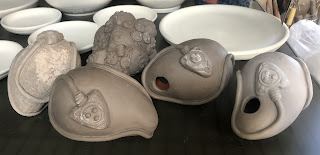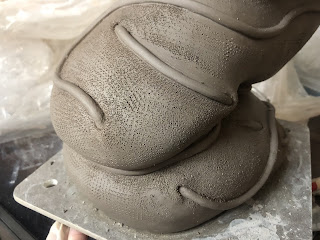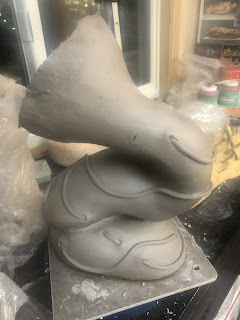CW: needles and blood
 |
| my most recent sculpture, nearly finished |
I started this sculpture without a real plan. Building feels good and in the week after my last, roughest, round of A/C chemo, it felt good to get into the studio and squish clay. Shortly after I started it, though, I got thinking about how to communicate the feelings of going through chemo, visually, in a sculpture.
 |
| port-a-cath bulb |
My friend Cheryl prompted me to start thinking about what I would make during this time and how making could be therapeutic or part of the process of going through cancer treatment. My initial thought was to do a kind of daily journal or art-a-day making process where each bulb I made would have a visual representation of chemo: needles and vomit bags and, breasts and lumps. I've done something similar with my protest/patriot/politics/resist bulbs. But how do you represent not eating? But before I'd thought too far, I realized that I didn't want to do this. Not only are a lot of the real feelings of chemo hard to represent visually, but the things that are easy to represent seem trite. Everyone already knows that breast cancer and chemo is about needles and vomit and breasts and pink ribbons. Plus I've already done a vaccination bulb. Yawn.
 |
| alternate port-a-cath design bulb |
What do I really think about when I think about my cancer and my chemo? It's the port-a-cath that's in my chest. I think about this thing all the time and as my Aunt Di phrased it, it gives me the "willies." I don't like needles and IVs and blood and all that, but all that is exactly what we have to do all the time for chemo and most of that comes through my port. For my pre-chemo blood draw, a nurse "accesses" my port. To be clear, she takes a needle and sticks it into this medical device that's been semi-permanently implanted in my chest. Ick.
 |
| port-a-cath bulb variations |
Then the next day another nurse accesses my port again for the chemo. I could leave the port accessed, but then I'd spend the entire day and night in between feeling this thing hanging out of my chest and I can't handle that kind of ick factor. They would cover the accessed port with this huge plastic cover thing, like my chest has a big sticky saran wrap cover over it, but I get the heebie jeebies just thinking about the port getting accessed, I would not feel comfortable actually having the physical thing just sticking out there for a full day.
From the outiside, the port looks and feels like a lump on my chest. Ironic, isn't it, that to remove a lump from my chest (breast), we've implanted a lump on my chest (upper)? Having this lump on my chest, under my skin is strange, though less strange than I thought it would be when I thought they were going to have the plastic/silicone part sticking out of my chest with a little cap or something they opened to access it.
 |
| scupture in progress with the port-a-cath and catheter lines in place |
But the thing that consistently creeps me out about the port is that I can feel the tube that connects the port to my vein (artery? idk). I can feel this tube, hose, catheter thing under my skin. I can feel how it comes out of the top of the port and then dives down into my anatomy somewhere. The idea that this is just under the skin, that it is not me, that only a thin layer of me protects it, and the idea that this thing goes into my blood stream, all of that I find gross and scary to think about. It makes me think how fragile human bodies are, at least when competing with sharp tools.
 |
| catheter lines disappearing into the surface |
The first time my port was accessed, for my first blood draw, it didn't work correctly right away. My (possibly warped) understanding it that the catheter line was kinked inside my body, like a hose that someone has bent to stop the flow of water. The nurse had me move my arms and neck to try to fix it, which worked, but she also had to recline my seat for me as the edges of my vision faded to grey because the idea of a kinked hose inside my body made me feel faint.
 |
| twisty, wrapping, icky medical hoses |
The fact that you can fix whatever the problem is by moving around makes me think that you can also cause problems by moving around. Did I cause this by exercising after the port-a-cath was put in? Should I hold my shoulder really stiff now, for, like, the rest of my treatment so that my hose doesn't kink again? The nurse said this wasn't necessary and it hasn't been a problem since.
 |
| these little guys were my first try with the port-a-cath forms |
As you can perhaps tell, the feelings I have about needles and implanted medical devices that can be felt through the skin, and blood, and tubes inside my body are strong. The imagery of the port-a-cath really encapsulates my kind of curious, queasy, disgusted, fascinated, uncomfortable feelings around chemo. The port-a-cath and the catheter lines themselves capture what chemo feels like to me much better than would a regular needle, though I've been poked with those plenty of times during this process, too. An emesis bag or a bottle of pills might communicate something about the routine after chemo, and might communicate to an unfamiliar audience, but the port-a-cath is this very specific medical device with very specific feelings for me.
 |
| the port-a-cath placed roughly on what I think of as the chest of my scupture |
And I think those feelings hold somewhat true for my fellow cancer patients/survivors/caregivers. I tried out an experiement the other week. After making a model port-a-cath on which to form a sprig mold, I shared a picture of it online and asked if folks knew what it was. I specifically tagged my cancer/chemo friends who immediately recognized it and shared stories about their experience. Folks who presumably hadn't had experience with cancer/chemo that requires this type of infusion offered other suggestions for what it was: a lawn sprinkler, a UFO, or a wine stop.
 |
| catheter lines weaving into the surface, photo right after the top fell off |
I also really wanted to capture the way the catheter line goes into the body. Visually, I don't think that leaving the port-a-cath and the line under the surface of the clay would communicate, so I tried to make it look like it went in and out of the surface of the form. Now that I'm finished with it, I'd like to see more variety in the depth of the line. I could try to make parts of the line appear to be just below the surface and that might capture the feeling I'm trying to express a little more clearly.
 |
| lines weaving under one another |
Obviously the real thing is much less impressive looking under my skin. I've got a scar from the surgery and then a bump. It so unimpressive that I've been unable to take a picture that really communicates what it looks like (the picture just looks like a scar line). I don't think someone looking at me could see the line of the catheter tube under my skin, so I've tried to exaggerate beyond the look of the thing and the real physicality of the thing to the way it makes me feel to know it is there (or to know that it needs to be adjusted to work right).
 |
| As the sculpture is about bionics, a mechanical sprig mold makes sense for this sculpture |
For many years, I've been trying to explore, in my sculpture, the place where nature and machinery meet: bionic additions to natural forms or mechanical or human made elements. How ironic, then, that I have become a natural form with a human made element added into my biology in order to try to improve my life. Life imitates art, in this case.
 |
| the scullpture pre-sprigs and while I was tring to sort out the surface |
This sculpture, in particular, felt like it got away from me a bit. I think that's a normal feeling when trying to explore a new space in art making. I wanted the surface to feel like it was getting out of control in a creepy kind of way, but in the meantime the form got a bit out of control, too. In fact, I had to support the top with a lump of clay (we'll call it an external armature to sound fancy) after it fully fell off at one point. It fell off because I was rushing the day before my last chemo because I wasn't sure if I'd feel up to working on it after.
 |
| the block of clay won't be there after firing |
The surface also got away from me on this one. I didn't entirely have a plan for how the surface would be once I added the tube lines, but I found that I couldn't smooth the surface next to the lines as well as I would like. This happened in part because of timing. I did take the day of chemo off from the studio, which meant the surface had dried more than I wanted it to. When I came back to it, I kept gouging the lines themselves or scratching the surface. I had to go back and do a lot more repair on this piece than I usually do. Part of the need for repair was the newness of the idea, but part was also my irregular studio time.
 |
| shortly after the top feel and I had to trim it down to replace it |
The other day someone suggested to me, half joking, I think, that not teaching during my chemo is a bit like a sabbatical. They're right in that I've got time away from work, but I took a sabbatical about 7 years ago and this is not like that. This is like a sabbatical except instead of travel or deep exploration of a research topic, I go to the doctor a lot and and feel sick and cold and tired a lot. The moments I have for exploration of a research topic (working in my studio), are interrupted by pain, nausea, and exhaustion.
 |
| tedius texture being added around the port-a-cath |
When I took a sabbatical back in the day, I had my research idea mapped out ahead of time, as well as my timeline for the work. I was able to devote my entire day (at least barring child pickup and drop off) and my entire week to the studio. I felt physically and mentally strong and was able to work on quite a few items at once. Working all day and on multiple projects at once is pretty normal for me in the summer, too. Now I have trouble getting into the studio daily and have to limit the time I spend in the studio when I'm not feeling well or simply feeling tired or sore.
 |
| neuropathy in my finger joints |
The nausea kept me out of the studio for up to a week every other week during my A/C chemo cycles. I've felt much better on my first Taxol cycle, but I've struggled with neuropathy (pain in my hands), soreness in my body, and general tireness. It's frustrating to go from doing a lot every day and every week, to feeling like you can't do as much. I was telling my family the other day that I felt like I wasn't sick enough to deserve to do as little as I was doing. My husband's response was to tell me I could help him in the garage. My mom told me I was allowed to rest. (Reader, I took my mom's advice.)
 |
| adding texture with the small tool |
This week I've felt very lucky not to have nausea, like at all, but I have had neuropathy and pains in my chest. I'm hoping the check pain is indigestion, but it is still uncomfortable and when the pain radiates to my back, it makes working in the studio uncomfortable. The end of this project was somewhat conducive to making the back pain, in particular, worse.
 |
| larger texture tools (the bottom two are pin frogs for flower arranging) |
On this project, since I was having trouble with the surface, I decided to apply a fine texture that will allow me some subtle color variation with underglazes later on. The process can be sped up with some texture tools (pin frogs for flowers and whatever the square thing is), but these only work on large flat or convex surfaces. When I try to use them in narrow spaces or inside curves, they don't reach or they bump into the catheter lines I'm trying to keep clear, so I need to switch to a much smaller tool.
 |
| applying texture one dot at a time inside the area where the other small tool won't reach |
Applying this texture took me about three days, with lots of breaks. It took me longer to apply the sprigs on the top, both because the sprig mold became too saturated and needed to dry for a bit and because I kept hurting myself. My fingertips are particularly dry and sensitive, probably as a side effect of chemo. I'm not sure if this is part of neuropathy or a separate issue, but the upshot is that my skin breaks with minimal contact.
 |
| trimming sprigs |
I use a needle tool to cut the edges of the sprigs I added to the top of the sculpture, but at one point I stabbed my finger with the end of the needle tool. On another occasion, which I didn't even register at the time, I scratched my thumb with one of my scoring or texture tools and it left score marks on the thumb for over a week. These little hurts are par for the course and fingers often get slightly injured in the clay studio, but my typical response of letting the clay get rubbed in and moving on is maybe not the best plan now.
 |
| layered sprigs on the top |
All the chemo take-home paperwork tells me that I should avoid cuts and bleeding. I'm supposed to limit the opportunity for infection and I think there is some concern that I could bleed too much. They specifically say to avoid contact sports and power tools. Obviously clay isn't a contact sport and these tools aren't powered, but it does make me worry more than usual about infection, so I try to wash out cuts and keep them covered as best I can.
 |
| finished form |

No comments:
Post a Comment
Tell me what you think about my work or this post